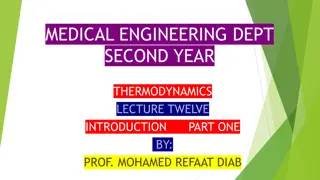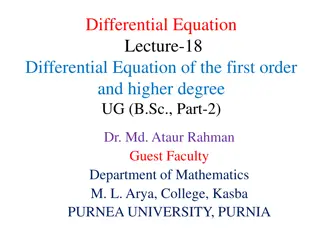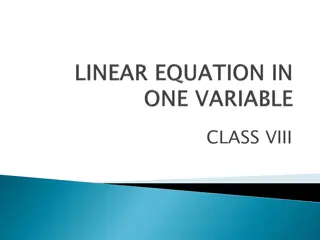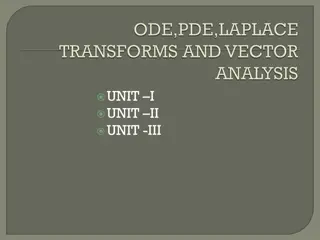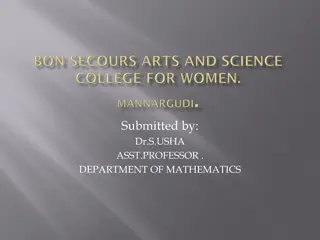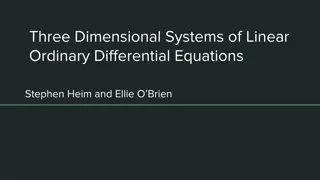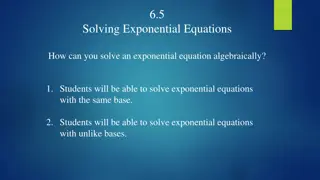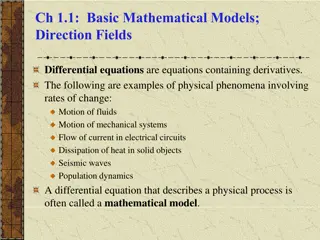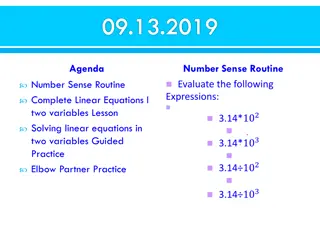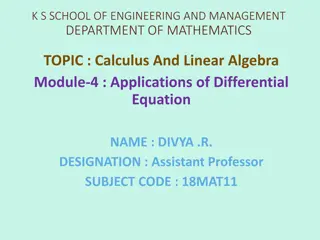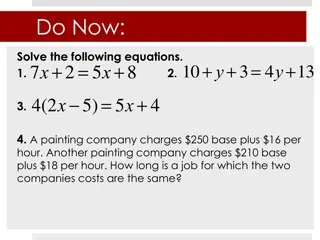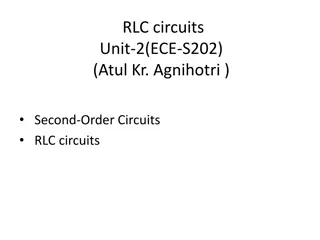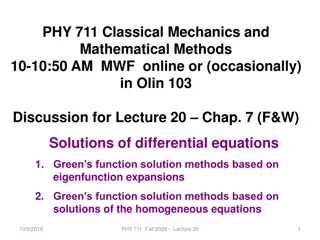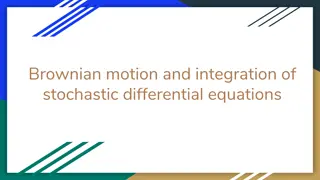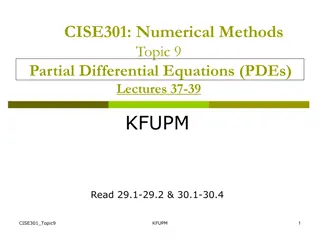Understanding Differential Equations: Types, Classification, and Solutions
Differential equations are mathematical equations that relate independent and dependent variables through differential coefficients. They can be classified as ordinary or partial, based on the types of derivatives involved. The order and degree of a differential equation, as well as its linearity and homogeneity, play crucial roles in solving them. Solutions to these equations involve finding relations that satisfy the given conditions. Various methods like direct integration are used to solve first-order differential equations.
Download Presentation

Please find below an Image/Link to download the presentation.
The content on the website is provided AS IS for your information and personal use only. It may not be sold, licensed, or shared on other websites without obtaining consent from the author. Download presentation by click this link. If you encounter any issues during the download, it is possible that the publisher has removed the file from their server.
E N D
Presentation Transcript
Definition A differential equation is a relationship between an independent variable, x, a dependent variable, y and one or more differential coefficients of y with respect to x. For e.g.
The Classification of DE Ordinary and Partial Differential Equations ODE is an equation involving ordinary derivatives of one or more dependent variables with respect to a single independent variable. PDE is an equation involving partial derivatives of one or more dependent variables with respect to more than one independent variables.
The Classification of DE (cont) The Order and Degree of a DE The order of a DE is the order of the highest derivative. The degree of a DE is the degree of the highest ordered derivative in the equation. For e.g. y(4)+ 6y2= 1 + x2 is the 4thorder and 2nddegree DE
The Classification of DE (cont) Linear and Non Linear DE Linear DE is an equation of order n is said to be linear if A. the dependent variable and its derivatives occur to the first degree only, B. no products of dependent variable or any of its derivatives are present and C. no transcendental functions of dependent variable and or its derivatives occur.
The Classification of DE (cont) Homogeneous and nonhomogeneous equations It can only apply to linear DE In a standard way, a DE is arranged so that all terms containing the dependent variable occur on the left-hand side (LHS), and those terms that involve only the independent variable and constant terms occur on the right-hand side (RHS). If the RHS of a linear DE is equal to zero,
Solution of DE A solution of a DE is is the relation involving only the variables and arbitrary constants, free of any derivatives or differentials that satisfies the given differential equation. For e.g. Show that y = sin2x satisfies the DE y +3y +4y=6cos 2x.
First Order DE Method 1: Direct Integration/Elementary DE The simplest form of a first order DE i.e. This can be solved in principle by integrating f(x) with respect to x.
Method 2: By separating the variables Consider equations of the form and of the form or i.e. equations in which the right hand side can be expressed as products or quotients of functions of x or of y. Example: Find the general solution of the DE 3y2y = 2x 1. Example: x(x 1)y = y(y + 1), with the
Method 3: Linear Equations use integrating factor 1st order linear DE in the form of To solve any such equation, we multiply both sides by an integrating factor (I(x)) which is always .
Thus, where I(x) = Example: Solve y + 2xy = 4x. Example: Solve y + tanx y = 2 secx
Method 4: Exact Differential Equation Def: The expression M(x, y)dx + N(x, y)dy is called an exact differential form in a domain D in the xy plane if there exists a function F(x, y), called the potential function, such that dF(x, y) = M(x, y)dx + N(x, y)dy for all (x, y) in D. Note that dF(x, y) is the total derivative, can be expressed as Def: If M(x, y)dx + N(x, y)dy is an exact
Theorem: Let M(x, y), N(x, y), , continuous functions in a domain D. The first order differential equation M(x, y)dx + N(x, y)dy = 0 is an exact differential equation if and only if for all (x, y) in D.
Example: Given the differential equation 3x(xy -2) +(x3+ 2y)dy = 0, determine whether it is an exact equation. If so, find the general solution. Example: Determine whether cos x y y sin x + 1 = 0 is an exact equation. If so, find the general solution.
Second Order Linear ODE Most practical problems in engineering give rise to second order differential equations of the form where a, b and c are constant coefficients and f(x) is a given function of x.
Homogeneous Case i.e. f(x) = 0 Consider the case where f(x)=0, that is equation of the form If y1and y2satisfy this equation, then any linear combination y = Ay1+ By2also satisfies this equation. If a = 0, we get the first order equation of the form where k=c/b.
Thus, it has the general solution where C is an arbitrary constant. If we put the symbol m for k, the solution is y = Cemx. It will also be a solution of the 2nd order equation ay +by +cy=0 i.e. aCm2emx+ bAmemx+ cAemx= 0 Divide both sides by emx am2+bm+c=0 This is called auxiliary equation (AE) or characteristic equation.
Since the AE is always a quadratic equation, we have three types of solution which depends on the roots. a) Real and different roots Let m = m1and m = m2be the two roots of the AE. Then , the general solution is b) Real and equal roots Let m = m1= m2is the solution of the AE. Then, the general solution is
c) Complex roots Let m = j , i.e. m1= + j and m2= - j be the solution of the AE. Then, the general solution is Example: Solve y -12y +36y=0 Example: Solve y +2y -3y=0 Example: Solve y -9y=0 Example: Solve y +7y=0
Non-homogeneous Case The solution of DE of are found by the following steps. 1. Solve and the solution is called the complementary function, yC. 2. Find a particular solution ypfor (Particular integral of DE) 3. The general solution of the non-homogeneous DE is y = yC + yp
Finding Particular Integral the Method of Undetermined Coefficients If f(x) = k, assume as P.I. is y = C. If f(x) = kx, assume as P.I. is y = Cx + D. If f(x) = kx2, assume as P.I. is y = Cx2+ Dx + E. If f(x) = k sin x or k cos x, assume as P.I. is y = C cos x + D sin x. If f(x) = emx, assume as P.I. is y = Cemx.
Common term found in P.I. and C. F. Since the C.F. makes the L.H.S of ay +by +cy to be equal to 0 , it is pointless to use a P.I., a term already contained in the C.F. If this occurs, multiply the assume P.I. by x and proceed as before. If this too is already included the C.F., multiply by a further x and proceed as usual.
Some Application Problems A. A particle moving a straight line has displacement x, velocity v and acceleration a at time t, where a = dv/dt = v dv/dx. These formula can be used to find v given a. The former is used when v is required in terms of t, the latter for v in terms of x. A particle moves with retardation proportional to its velocity i.e. a = kv and has initial velocity v0and initial displacement 0. Find the velocity in term of time; and in term of displacement. i.
B. A charged oil drop of mass m, falling with velocity v, experiences a weight force mg downwards, a drag force kv upwards and an electric force Esin t upwards, where g, k, E and are constant and t is the time. i. Using Newton s 2ndlaw (i.e F = m dv/dt where F is the resultant force) derive a differential equation for v. ii. Solve the DE to find v in terms of g, k, E, and t.
C. The equation of motion of a mass on the end of a vertical spring is y + 4y =0, where y is the displacement of the mass from the static equilibrium position. Given that the initially (i.e. at time t = 0), the displacement , y is 3 and the velocity, y is 8. Find the solution to the equation in the form y = C cos( t + ).
D. Given an electric circuit with a resistance (R) of 2 ohms, an inductance (L) of 1 henry, and a capacitance (C) of 0.2 farad, and electromotive force (V) of 17 sin2t volts (where t is the time in seconds), find the current (i, in ampere), the transient current (i.e. that part of the solution which approaches zero as t ) and the steady current (i.e. that part of the solution which does not approaches zero as t ), given that i satisfies the differential equation and that i = 0 and di/dt = 0 when t =0.



